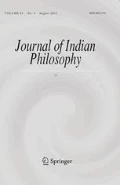Abstract
The problem of empty terms is one of the focal issues in analytic philosophy. Russell’s theory of descriptions, a proposal attempting to solve this problem, attracted much attention and is considered a hallmark of the analytic tradition. Scholars of Indian and Buddhist philosophy, e.g., McDermott, Matilal, Shaw and Perszyk, have studied discussions of empty terms in Indian and Buddhist philosophy. But most of these studies rely heavily on the Nyāya or Navya-Nyāya sources, in which Buddhists are portrayed as opponents to be defeated, and thus do not truly reflect Buddhist views on this issue. The present paper will explore how Dignāga, the founder of Buddhist logic, deals with the issue of empty subject terms. His approach is subtle and complicated. On the one hand, he proposes a method of paraphrase that resembles Russell’s theory of descriptions. On the other, by relying on his philosophy of language—the apoha theory, he tends to fall into a panfictionalism. Through the efforts of his follower Dharmakīrti, the latter approach would become more acceptable among Indian and Tibetan Buddhists. Dignāga’s Chinese commentators, who were free from the influence of Dharmakīrti, dealt with the empty term issue in three ways: (1) by adhering to Dignāga’s method of paraphrase; (2) by allowing exceptions for non-implicative negation; and (3) by indicating the propositional attitude of a given proposition. Among these, the third proved most popular.
Similar content being viewed by others
References
Primary Sources
gCig du bral gyi rnam bzhag of A lag sha ngag dbang bstan dar. The Tibetan text in Tillemans 1999; pp. 258–265; The English translation by Tillemans and Lopez in Tillemans 1999; pp. 249–258.
Limenlun shuji理門論述記 of Shentai, T1839.
Mahāvibhāṣā, T1545.
Nyāyamukha of Dignāga, T1628.
Pramāṇasamuccayavṛtti of Dignāga, translated by Vasudhararakṣita and Seng rgyal, Peking 5701; Derge 4204.
Pramāṇasamuccayavṛtti of Dignāga, translated by Kanakavarman and Dad pa’i shes rab, Peking 5702.
Pramāṇavārttika-svavṛtti of Dharmakīrti, edited by R. Gnoli, Roma, 1960.
Yinming ru zhengli lunyi zuanyao因明入正理論義纂要 of Huizhao, T1842.
Yinming ru zhengli lunshu因明入正理論疏 of Kuiji, T1840.
Secondary Sources
Dhammajoti, K. L. (2007). Sarvāstivāda Abhidharma. Hong Kong: Centre of Buddhist Studies, The University of Hong Kong.
Edgerton, F. (1986). Mīmāṃsānyāyaprakāśa. (Ed. And Trans. By F. Edgerton). Delhi: Sri Satguru Publications.
Franco E. (2004) Xuanzang’s proof of idealism (vijñaptimātratā). Hōrin 11: 199–212
Frankenhauser U. (1996) Die Einführung der buddhistischen Logik in China. Harrassowitz Verlag, Wiesbaden
Funayama T. (1991) On Āśrayāsiddha. Journal of Indian and Buddhist Studies 39(2): 1027–1021
Harbsmeier C. (1998) Science and civilisation in China Volume 7 Part I: Language and logic. Cambridge University Press, Cambridge
Horn L.R. (1989) A natural history of negation. University of Chicago Press, Chicago
Kajiyama Y. (1973) Three kinds of affirmation and two kinds of negation in Buddhist philosophy. Wiener Zeitschrift für die Kunde Südasiens 17: 161–175
Katsura, S. 桂紹隆. (1981). Immyō shōri mon ron kenkyū (IV) 因明正理門論研究(四). Hiroshima Daigaku Bungakubu kiyō広島大学文学部紀要, 41, 62–82.
Katsura, S. (1992). Dignāga and Dharmakīrti on adarśanamātra and anupalabdhi. Asiatische Studien, 46(1), 222–231.
Kitagawa, H. 北川秀則. (1965). Indo koten ronrigaku no kenkyū; Jinna (Dignāga) no taikeiインド古典論理学の研究; 陳那(Dignāga)の体系. Tokyo: Suzuki Gakujutsu Zaidan.
Lusthaus D. (2002) Buddhist phenomenology. New York and London, RoutledgeCurzon
McDermott A.C.S. (1970) Empty subject terms in late Buddhist logic. Journal of Indian Philosophy 1: 22–29
Matilal B.K. (1968) The Navya-Nyāya Doctrine of Negation. Harvard University Press, Cambridge, MA
Matilal B K. (1985) Logic, language & reality: Indian philosophy and contemporary issues. Motilal Banarsidass, Delhi
Perszyk K.J. (1984) The Nyāya and Russell on empty terms. Philosophy East and West 34(2): 131–146
Priest G. (2005) Towards non-being: The logic and metaphysics of intentionality. Oxford University Press, Oxford and New York
Russell, B. (1994). On denoting [1905]. In The collected papers of Bertrand Russell. Volume 4: Foundations of logic 1903–1905 (pp. 414–427). London and New York: Routledge.
Shaw J.L. (1974) Empty terms: The Nyāya and the Buddhists. Journal of Indian Philosophy 2: 332–343
Shen J. 沈劍英. (2002). Yinming xue yanjiu因明學研究. Shanghai: Dongfang chuban zhongxin.
Tillemans T.J. (1999) Scripture, logic, language: Essays on Dharmakīrti and his Tibetan Successors. Wisdom Publications, Boston
Author information
Authors and Affiliations
Corresponding author
Rights and permissions
About this article
Cite this article
Yao, Z. Empty Subject Terms in Buddhist Logic: Dignāga and his Chinese Commentators. J Indian Philos 37, 383–398 (2009). https://doi.org/10.1007/s10781-009-9071-2
Published:
Issue Date:
DOI: https://doi.org/10.1007/s10781-009-9071-2




